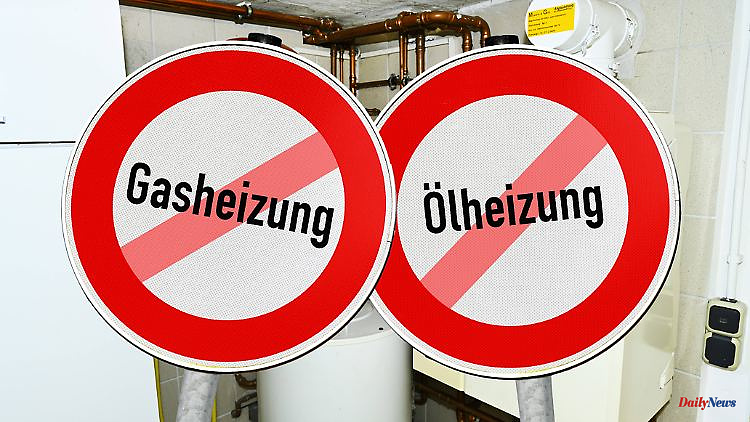The Economics Minister is currently causing unrest with an early ban on new gas and oil heating systems. Although the draft law is not yet a foregone conclusion, it can still be worthwhile to find out about alternatives and how to promote them.
Making the world a little better and fairer every day is always a good idea. In practice, however, this sometimes turns out to be more difficult than expected. Economics Minister Habeck was also able to experience this once when he wanted to make heating even more expensive with a possible gas levy. It is well known that his plan failed. Instead, there is now the gas price brake. Oh well ...
However, this does not prevent him from again causing unrest and resentment among large parts of the population. After all, he wants to replace oil and gas heating systems with non-fossil systems in the long term by law. And this in a first step from 2024. Apart from the fact that the matter is not yet a settled matter within the governing coalition, the minister has already calmed down and put his initiative into perspective. Almost half of the 41 million households currently heat with natural gas. Heating oil warms 25 percent of the apartments and district heating a good 14 percent.
Nevertheless, the share of fossil fuels in the heat supply should be reduced. To do this, the quota of renewable energies must be expanded and energy efficiency increased. That's the plan. In view of the current general weather situation, some may temporarily give a damn about the future and still flirt with holding on to their oil or gas heating. And contrary to popular belief, homeowners can easily install a new oil heating system until the end of 2025. This applies even longer to buildings in which no alternative heat generation to oil is possible, for example in regions without a comprehensive gas supply. In this case, the climate protection package provides for exceptions, and oil heaters can also be installed after 2026.
Anyone who is still alarmed or would like to make the world a little better all by themselves, and would like to replace an oil or gas heating system with a climate-friendly heating system that does not support rogue states, could opt for the alternatives listed below and the corresponding subsidies via federal funding for efficient buildings (BEG). The BEG includes cheap loans that can be applied for through the KfW, as well as grants from the Federal Office of Economics and Export Control (BAFA) for all types of heating to be mentioned. The subsidy amounts mentioned below refer to the BEG subsidy, as Alexander Steinfeldt, energy expert from co2online, explains.
Here we go:
biomass heaters
With a biomass heating system, wood is burned instead of a fossil fuel to heat the heating fluid. In the form of pellets, split logs or wood chips. Pellet heating systems are fed automatically via a screw conveyor, making them more convenient than firewood boilers that have to be filled by hand, but they are also up to 5,000 euros more expensive, as Steinfeldt explains. The installation of a pellet heating system can be had for 17,000 to 25,000 euros. A log gasification boiler costs 13,000 to 15,000 euros - but heating with wood is also bad for the environment. "Biomass-based heating systems will not be able to replace all gas and oil heating systems. Because we also need the forest in Germany for other purposes. Around ten percent of the heating systems will run on wood in the future. Owners with wood heating systems should make sure that their wood comes from sustainable forestry and comes from the region", Steinfeldt points out. Irrespective of this, wood is one of the renewable energies.
The basic subsidy is 10 percent, but increases by the heating exchange bonus of 10 percent if an oil heating system or old gas heating system is replaced. However, the bonus applies to most heaters funded by BAFA. In addition, the funding is tied to strict criteria: the boiler must be particularly efficient and the fine dust pollution must be low. In addition, the pellet heating system must be combined with a solar thermal system or a heat pump.
combined heat and power plants
Plants in which electricity and heat are generated at the same time are referred to as combined heat and power plants (CHP plants). A fuel such as coal, natural gas or environmentally friendly biomass is usually burned to generate electricity and heat. The resulting heat drives a turbine and thus generates electricity or heats a medium that is then distributed to households via a heating network. If the combined generation of electricity and heat takes place in a smaller, compact system and not in a large combined heat and power plant, then this is referred to as a combined heat and power plant (CHP). They are preferably operated at the place of heat consumption (in your own basement) or feed the heat into a local heating network. By using the energy to generate electricity and heat, efficiency levels of more than 90 percent can be achieved.
Combined heat and power plants are usually too big for the typical single-family house and generate too much electricity. That makes them uneconomical. But there are also cases and systems that could also be considered for your own home. Homeowners should really get good advice here, because there aren’t that many off-the-shelf CHP options, warns the energy expert. If the CHP is operated with natural gas, you remain dependent on fossil fuels and will continue to pay the CO2 price in the future.
The acquisition costs are between 15,000 and 30,000 euros. Funding from the BEG is out of the question for CHPs. But with the KfW loan 270 (renewable energies) you can at least have the costs financed. In addition, the electricity that is not required can also be fed into the grid, for which a feed-in tariff is paid.
fuel cell heating
In a fuel cell heater, hydrogen reacts with oxygen. This creates direct current and heat. An inverter converts the direct current into alternating current so that it can be used in the home. The heat generated is used for hot water and heating.
A so-called reformer turns natural gas and water vapor into a hydrogen-rich gas. The hydrogen reacts with oxygen in the fuel cell. This creates direct current and heat. An inverter then converts direct current into usable alternating current. The heat generated is used for heating and for heating drinking water by means of a heat exchanger and buffer storage tank.
A fuel cell heating system including installation costs from 30,000 euros. About 23,000 euros of this must be planned for the device itself. The rest comes from the prices for accessories and installation. There are also subsidies for fuel cell heating systems.
Fuel cell heating systems are only funded if they are operated with green hydrogen or biomethane. So homeowners should make sure they have safe access to these precursors, otherwise procurement could become expensive. "The high acquisition costs only make this type of heating economical in the long term. However, electricity and heat are generated very efficiently," says Steinfeldt. However, use in typical single-family homes is rare, so there are only a few suppliers and specialist tradesmen for installation.
heat pump heaters
Heat pumps are generally regarded as a climate-friendly alternative to conventional systems such as gas or oil heating. Heat pump heating systems are already the first choice in new buildings. They are also being used more and more frequently in existing buildings. It is true that heat pumps require a high level of energy efficiency, for example through appropriate building insulation. But in many cases this is not an obstacle to use.
Basically, they work like an inverted refrigerator. While the coolant in a refrigerator removes heat, a heat pump brings it into the house. The heat required for this comes from the ground, groundwater or the outside air. If the heat requirement exceeds the output of the pump, additional electricity is required for an additional heating element. This electricity can, for example, come directly and cheaply from your own photovoltaic system or a connected battery storage system. Heat pumps are therefore particularly worthwhile in this combination. Of course, it can also be operated using more expensive electricity from the grid.
Including the installation, an air heat pump costs between 16,500 and 20,000 euros. The groundwater heat pump costs about the same, with additional development costs of 5,000 to 10,000 euros. With the geothermal heat pump, the price including installation is between 15,000 and 20,000, a distinction is made between pumps with geothermal collectors and probes. A deep bore of about 100 meters is necessary for probes - there are an additional 50 to 75 euros per meter of bore depth. If the subsoil is very rocky, it can even cost up to 100 euros. Ground collectors weigh in at around 25 euros per square meter.
Since many homeowners are wondering whether their building is suitable for a heat pump, co2online has developed a heat pump check. With just a few details about the building, homeowners can check which requirements their building meets and which measures still need to be implemented.
The federal subsidy for efficient buildings (BEG) applies to heat pumps, and users are entitled to 25 percent of the basic subsidy. If you want to replace an old gas or oil heating system, you can count on a further 10 percent. There is also a 5 percent bonus for either natural refrigerants or the choice of a ground or water pump. The maximum subsidy amount of the BEG is therefore 40 percent.
solar thermal system
The power of the sun can be used to prepare hot water and/or to support the heating system. A solar thermal system converts solar energy into heat. This heat is used to heat drinking water or for heating. For this purpose, so-called solar collectors are mounted on the roof of the house and connected to the heating system in the basement. The technology for solar thermal energy is considered to be largely mature, and the sun shines sufficiently throughout Germany. However, the heat that is not required in the household cannot currently be fed into public heating networks. In addition, the storage capacity of most systems is not large enough to store this heat for a long period of time.
As a rule, a solar thermal system does not completely cover the need for heating energy, but is combined with a conventional heating system. In so-called solar houses, on the other hand, solar thermal energy is the most important or even the only heat source in the house. Due to the enormous need for storage volume and collector area, however, this concept is rarely implemented.
In many cases, solar thermal systems are a sensible investment, says Steinfeldt. They can be easily combined with existing heating systems, such as pellet boilers. If you really want to become independent, you can't avoid solar energy. When choosing a specialist company, homeowners should ensure that they already have extensive experience with solar thermal energy.
A corresponding system costs between 5,000 and 10,000 euros for an average single-family home. The decisive factor is whether the system should only be used to generate hot water or also for heating. There are BEG grants of up to 35 percent.
Another word on promotion
In addition to the federal funding for efficient buildings (BEG) mentioned, there are also many regional or sometimes local funding programs. Homeowners should look for them specifically. A first entry point can be the subsidy check from co2online. Here, those who want to renovate will find the right one for their project from over 1000 funding programs.
(This article was first published on Sunday, March 05, 2023.)












